Anxiety
Anxiety is common and can affect anyone. The good news is that there are effective treatments that can help. Here you will learn more about anxiety and how to treat it.
You can use any lesson at any time. However, therapy for anxiety usually uses this order:
Learn the facts about anxiety -- what it is, what it feels like and most importantly, how it's treated.
Too much worrying can be tiring and stressful. Learn the skills you need to stop worrying and quiet your mind once and for all.
Beliefs about worrying often keep people stuck. In this unit, you'll learn how to disprove the myths about worrying that make it difficult to let them go.
Trying to suppress your thoughts can make them worse. In this unit, you will learn how to think about your worries in a new way using coping plans.
Life is uncertain. Trying to control everything in life can fuel your worries and occupy a lot of your time. Learn the skills you need to cope with the uncertainty of life.
When certain thoughts seem immune to challenging, a core belief might be keeping you stuck. Here you’ll learn how to rework them.
Anxiety creates muscle tension and makes it hard to relax. Learning to relax is a skill that will help you reverse the cycle of anxiety.
When you've got a problem, you need to do more than challenge negative thoughts. Here you'll learn how to cope in these situations.
In this unit, you will learn how you can feel better by challenging the thoughts that bring you down.
Learn about the types of medications used to treat depression and anxiety.
Keep practicing. Download reusable worksheets and other tools to keep you going.
What is Anxiety?
7minIt’s normal to feel anxious sometimes. But when anxiety becomes chronic or stops you from leading a full life, it’s time to do something about it. Sweaty palms, racing thoughts, shortness of breath. These are some of the symptoms that can take over your life and leave you feeling miserable. Fortunately, there are effective treatments that can help you feel better and quiet your mind!
- The Facts
- Understanding Anxiety
- The Symptoms
- Treatment
! For your privacy, this site does not save what you type. To save it or have a therapist review it, please download your work at the end of your session.
The Facts
It Can Happen to Anyone
We don’t know why some people develop anxiety disorders and others don’t. Anxiety disorders do seem to run in families. Trauma or frightening experiences may also worsen anxiety. People who have learned to avoid the things that make them nervous are at higher risk as well.
It’s the Number One Concern
Millions of people struggle with anxiety. In fact, anxiety is the most common of all mental health concerns. Studies report that over 1 in 4 people will struggle with a form of anxiety at some point in their lives. You are not alone!
We Need Fear
We have anxiety for an important reason – to protect us from real danger. It stops us from going down dark alleys, walking too close to the edge of a cliff, or getting too close to a wild animal.
Nature favors anxiety. Anxious parents tend to keep their anxious children safe. As a result, feelings of anxiety get passed down from generation to generation.
You may be surprised to learn that your brain doesn’t care if you’re happy – it just wants you to survive. Hiding in a cave all day, but surviving, was a good day for our ancestors! Even if we are no longer exposed to the same dangers as early man, our brains are still attuned to notice a threat. We have survived as a species because our brains pick up on dangers and react quickly to keep us safe.
Anxiety is Not Dangerous
One of the most important things to know about anxiety is that it is not dangerous! It can feel uncomfortable and be hard to ignore – but it will not harm you.
Anxiety is kind of like a smoke detector. If the alarm goes off, you need to check to see if there is any real danger. If your kitchen is on fire you need to take action. If the toast is burning, you’ll open the windows and clear out the smoke.
You would never rip the smoke detector out of the wall! You need it, even if it can be annoying when the alarm goes off at the wrong time.
Understanding Anxiety
So when does anxiety become problematic? The answer depends upon our perception.
In any given situation, we perceive the level of danger and our ability to cope with it. Those who suffer from anxiety tend to misread the signs. They inflate the level of danger and underestimate their ability to handle it.
This tendency can lead to elevated fear and tension, even when there’s no serious threat.
Symptoms of Anxiety
Anxiety is complex and can affect you in many ways. There are four types of symptoms used to identify anxiety. Doctors and therapists look for these signs to decide if someone’s anxiety is of concern.
Anxiety can overwhelm you. Focusing on what may go wrong in the future, even if unlikely, is common. You might also try to think of ways to prevent outcomes that are actually outside of your control.
Along with feeling anxious, problems with anxiety can cause other emotions like irritability. Many people notice they are impatient and become frustrated easily.
An episode of anxiety can change your body. Your heart might start racing. You may have shortness of breath or start to feel pain in your chest. It might even make you dizzy, weak or nauseous. Feeling tense and tired, but having trouble relaxing or sleeping, is also common.
People with anxiety often start avoiding situations that they fear. They can also become more active and do whatever they can to prevent danger.
A New Relationship with Anxiety
A key to treatment is developing a new relationship with anxiety. Remember, some people actually like feeling anxious! They pay good money to go skydiving or ride monster roller coasters.
While you may never love anxiety, you do need to learn to cope with its physical symptoms. You’ll be able to push yourself to do the things you’ve been avoiding. To overcome anxiety you must learn to talk back to your worries and challenge them.
Treatments
The good news is that anxiety is treatable! Different kinds of therapy and medications can get you feeling better:
There are many types of psychotherapy or talk therapy. Kelty's Key is based on cognitive behavioral therapy. This method teaches you to challenge your worries and learn new coping skills.
Different medications can be used to treat anxiety. You should discuss the options with your doctor. It can take time to find the best medication for you.
Well Done. You’re on Your Way.
You’ve taken the first step and learned about anxiety. Knowledge is important. Understanding what anxiety is and how it works will help you moving forward.
Worrying
12minConstant worrying can eat up all of your energy and take over your life. You can’t just tell yourself to stop worrying and actually stop. You have to learn how to talk back to your worries and focus your attention in a different direction. It doesn’t matter if you worry about money, school or making the right decision. You can learn how to quiet your mind.
- What is Worrying
- What Works
- What Doesn’t Work
- Creating a Worrying Profile
! For your privacy, this site does not save what you type. To save it or have a therapist review it, please download your work at the end of your session.
What is Worrying?
Worries are a particular kind of negative thought. If you want to stop worrying, it is important that you understand how they work. Some key features of worrying are:
- Focusing on the future
- Downplaying your ability to cope
- Responding to triggers
- Multiplying your anxiety with “worry chains”
- Believing you can’t stop worrying
We’ll examine these features in more detail. As you learn, we’ll collect your thoughts and ideas to create your Worrying Profile.
Focusing on the Future
People who worry often think about the future and ask themselves, “what if?” "What if they don't like me?" "What if I fail?" In fact, you might hear some therapists call Generalized Anxiety the "What If Disease”! It's impossible to solve a problem that hasn't happened yet. Your mind can go in circles for days trying to make that doubt go away.
Take a moment to list some of your common worries. What if...
Downplaying Your Ability to Cope
One of the reasons we worry is because we don't feel sure that we could handle ourselves if things went wrong. People who don't worry live by the motto “I’ll cross that bridge when I get to it.” In other words, they know if something difficult happens, they can handle it. If you don't feel confident in your abilities to cope it's hard to stop worrying.
You need to learn to remind yourself of all the problems that you have handled in the past. Don’t downplay your abilities to cope when things get hard. With practice, you'll get better at believing that you can cope if tough times come in the future.
Try to remember a few bad situations that you coped with in the past. What things have you successfully dealt with before?
Responding to Triggers
You've probably noticed that certain situations, thoughts or feelings can set off your worrying. It could be anything. A random thought that pops into our head can start a chain reaction of worries. These worry provokers are called triggers.
It can seem natural to avoid your triggers, but facing them is the best way to defeat them. Taking on your triggers will help you stop trying to protect yourself from bad news.
Take a moment to list some of your triggers. What kinds of things get you worrying?
Multiplying Your Anxiety with Worry Chains
A worry chain is when one negative thought leads to another and another. People who worry tend to have great imaginations. The problem is that they can worry 20 years into the future!
Take someone who worries about failing an exam. This worry could lead to others like "Then I won't get a good job!" --> "Then nobody will want to marry me!" --> "Then I'll live a lonely and sad life." --> "And probably work at a job I hate and always be in debt."
Worry chains need to be broken apart and challenged. You’ll use that good imagination of yours to come up with ways you could cope in each situation.
Pick one of the worries that you listed earlier and see if you can turn it into a worry chain:
Your worries: What if it’s the wrong choice?, What if I regret it?, What if I embarrass myself?



Believing You Can’t Stop Worrying
Many people report that their worries are uncontrollable. They believe that there is nothing they can do to stop the flurry of thoughts that keep them up at night.
It might surprise you to learn that worrying is actually a behavior that you can change. Your mind isn't worrying all the time. Think about those days when you are especially busy and don't have time to worry. Something was able to turn the worries off.
Like any habit, learning to shut off your worries when you want takes practice and patience. The good news is that many people learn how to shift gears and shut down worrying when it tries to take over.
Try to remember times when you were too busy to think about your worries. What activities help you “forget” to worry?
What Doesn't Work
There are many sensible approaches to worrying that may work briefly. But when worrying becomes a habit these strategies can make it worse in the long run. Before we talk about what does work, let’s have a quick look at what doesn’t.
Telling yourself to stop worrying rarely helps you to stop. Neither does snapping a rubber band on your wrist. Trying to silence your worries almost always leads to more worries. Let's do a test. Try not to think of a pink elephant! If you do, tell yourself to stop. You'll find the harder you try, the harder it is to get that elephant out of your mind! The same is true for worrying.
Some people push away worries by keeping busy. This way they don't have time to think about what is upsetting them. It's not a bad strategy for a short term problem or just after a trauma. But if you continue for too long, you can become exhausted from never being able to let your mind rest. There are better ways than staying busy to keep worries from taking over your thoughts.
Reassurance not only makes anxiety worse, it can be draining for your friends and family. Asking if it's going to be okay might make you feel better for a little while. But the more we ask for reassurance, the more we need it. It's a tough habit to break, but the urge to ask for reassurance does diminish over time.
Avoiding what scares you makes anxiety worse. Different people will avoid different triggers. Some people stop flying, others stop watching the news. The big problem with avoidance is that it tends to grow. Over time you may find that you can do fewer and fewer of the things that you once enjoyed.
Trying to force yourself to believe something positive can make you feel worse. You can't just drop a thought and replace it with a new one. You need to be able to challenge the original negative thought until you don't believe it anymore. For more practice, check out the Thought Challenging unit.
Strategies That Work
Luckily, there are many strategies that are effective for treating anxiety and worrying. A few good methods and skills are:
- Coping plans (for worst case scenarios)
- Problem solving (for things that have already happened)
- Thought challenging
- Coping with uncertainty
- Redirecting your attention (a little different than distraction)
You can learn about each of these techniques over the next few weeks. It’s a good idea to take your time and practice each skill one at a time.
Good Job! You've Created a Worrying Profile
Download Your Worksheet
Good job! You've learned about the features of worrying and how to stop it. Take a look at your Worrying Profile and share it with your therapist or healthcare provider. Over the next few days, pay attention to your worrying and see if you can add more information to your profile.
Congratulations! You’re on Your Way to Taking Charge of Your Worries
Continue to pay attention to your worrying. Try to add more information to your Worrying Profile. If you’re feeling stuck you can review this unit or talk to your therapist or healthcare provider.
Worrying About Worrying
15minA lot of people believe that worrying is powerful. Some people think that worrying helps them solve problems. Others are sure it will harm them. Either way, these myths about worrying can keep you stuck. To overcome anxiety, you need to do more than just challenge your worries. You must learn to identify your beliefs about worrying and break them down.
- Beliefs Keep You Stuck
- Positive Beliefs About Worry
- Negative Beliefs About Worry
- Challenge Your Beliefs
! For your privacy, this site does not save what you type. To save it or have a therapist review it, please download your work at the end of your session.
Beliefs That Keep You Stuck
There are two kinds of beliefs about worrying that can keep you stuck. The first is positive beliefs. When you think that worrying is a good thing, you might not want to stop. If worrying helps you solve your problems, why would you want to learn ways to worry less?
The other type of belief is that worrying is bad. These myths cause just as much trouble. If you believe that worrying is harmful you might try really hard not to worry. But suppressing your worries usually backfires and makes you worry more.
To let go of your fears you need to challenge your positive and negative beliefs about worrying. This will help you learn that you don’t need to worry to make sure nothing bad happens. It will also make it easier not to panic when you do worry.
Positive Beliefs About Worrying
It is unlikely that you would want to give up something that was helpful. Nobody would want to stop doing something that helped them succeed or prevented catastrophe! This is why it is so important to talk about positive beliefs about worrying.
Take a look at some of the common positive beliefs about worrying. Do you think you have any of these beliefs? Rate how much you believe each one to be true (where 0 = not true and 10 = very true).
Challenging Positive Beliefs
Let’s take a look at your strongest belief and start challenging it together.
positive_belief
Do you know for sure this is true?
If you had to convince someone that this was not true, what would you say?
Break it Down
Are there other ways to accomplish this goal without worrying?
What are the benefits of worrying about this?
What are the downsides of worrying about this?
Worrying is Often Not That Helpful
You may have believed that worrying can be helpful. Yet, when you take a closer look, this belief can fall apart.
You don’t need to worry about someone to show that you care. You can give them a call, spend time with them or offer help when they need it. Worrying doesn’t protect you either.
Can you remember times when you worried and bad things happened anyway? Worrying didn’t change the outcome one bit!
Problem solving works better than worrying to cope with hard times.
Take a moment now to rerate your positive belief about worrying. Do you still think it's true?
Negative Beliefs About Worrying
Many people believe that worrying is dangerous. It certainly doesn’t feel good. Your heart can start racing, you may have pain in your chest or start to feel dizzy.
If you believe that worrying is harmful you might start to panic when it happens. Some people who fear worrying will hurt them try not to worry at all. This is even worse than panicking. Trying to push your worries aside can make them bigger and bigger! When you have negative beliefs about worrying you make your anxiety harder than it needs to be. That’s why it’s important to take these beliefs and challenge them.
Let’s review some of the common negative beliefs about worrying. Rate how much you believe each one to be true (where 0 = not true and 10 = very true).
Challenging Negative Beliefs
Let’s take a look at your strongest belief and see if you can start to challenge it!
negative_belief
Do I know for certain that this is true?
If I had to convince someone that this was not true, what would I say?
Keep Challenging
Can you think of other people you know who have not been harmed by the stress of worry?
What are the benefits of worrying about this?
What are the downsides of worrying about this?
Worrying is Less Dangerous Than You Think!
It may be exhausting but worrying is not dangerous. Remember, there are some people who actually thrive under stress. They do extreme sports or enjoy having a challenging job. The excitement that causes them to have a rapid heartbeat or sweaty palms will not harm them at all.
The good news is that the stress you feel when you worry won’t harm you either. Our bodies can handle a lot. You don’t need to add to your worrying by thinking that you are doing yourself harm.
Take a moment now to rerate your negative belief about worrying. Do you still think it’s true?
Millie's Story
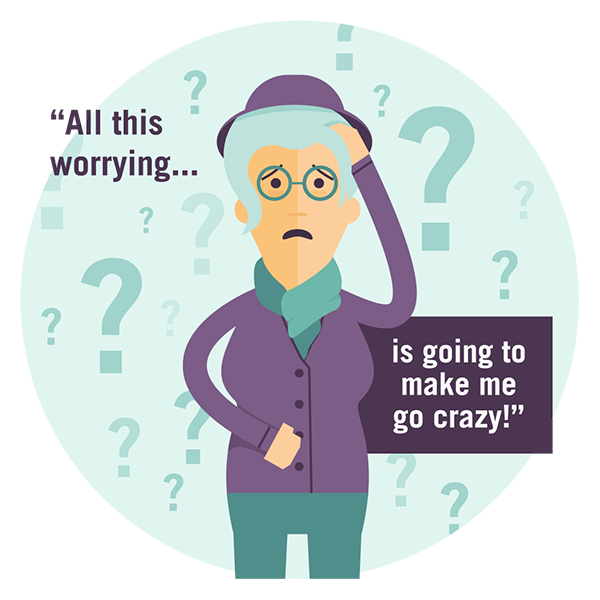
Millie's anxiety had really taken over. She was worrying about lots of different things and felt like she just couldn't stop. On top of that, she felt sure that all this worrying would make her go crazy. Now she was worrying about worrying!
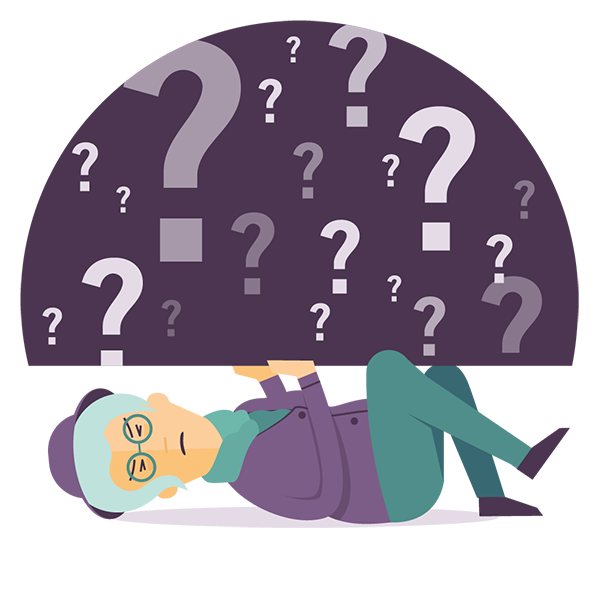
To avoid more anxiety, Millie tried to push away her worries. She tried to suppress her thought that worrying was harmful. The more she tried not to think about it, the more she did. Her worries were taking up all her time and energy.
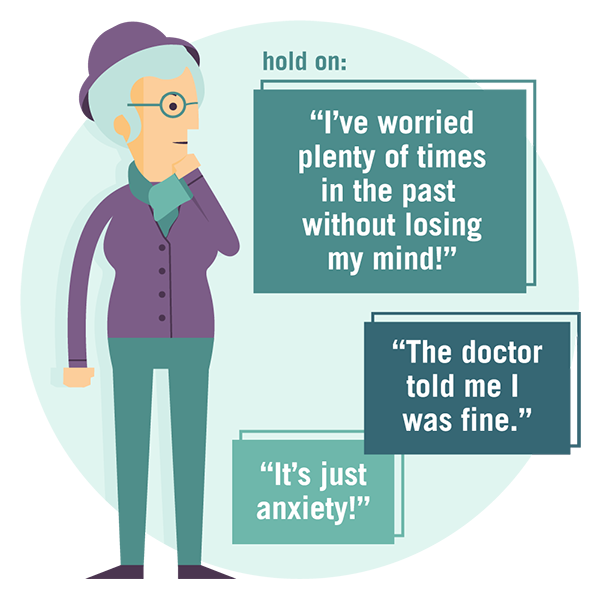
Millie decided to try and challenge her belief that worrying would make her crazy. She reminded herself that she’d worried plenty of times in the past without losing her mind. She'd also visited the doctor who ruled out any serious medical issues. He told Millie "it's just anxiety" and that "she's fine." Just anxiety feels terrible, but Millie was beginning to consider that it wasn't dangerous.
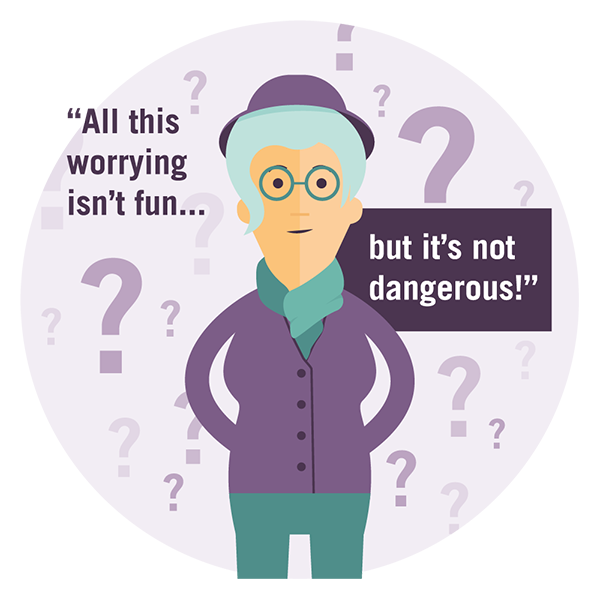
The more Millie practiced reminding herself that it was okay to worry the easier it got not to panic when she did. Worrying may be uncomfortable but it’s not dangerous. Millie decided it didn't make sense to worry about worrying. It was only making things worse.
Good Job! You’re Challenging Your Beliefs
Download Your Worksheet
Worrying isn't good or bad, but it isn't exactly fun. It can feel terrible and take up a lot of your time. You don't need to double your pain by worrying about worrying. Keep challenging how you think about worrying. Remember that positive beliefs make it harder to let go. They can stop you from learning the skills you need to overcome your anxiety. Once you trust that you can achieve your goals without worrying it is easier to worry less. Negative beliefs about worrying can make your anxiety worse. You need to challenge these beliefs to get some relief. It doesn't make it any easier to cope with anxiety if you think worrying is dangerous. Download your worksheet to remind yourself how you can challenge your beliefs about worrying. You can reuse it to challenge new beliefs as well.
Congratulations! You've Started Challenging Your Beliefs About Worrying
Continue challenging your positive and negative beliefs about worrying. You can reuse the questions in your worksheet to break apart other beliefs you might be holding on to.
Coping Plans
10minYou can go in circles for hours or days with worries without finding any relief. Most people will tell you not to think about it. Others will point out that your worries will never happen so you should just let them go. The problem is these common sense approaches can make worries worse! To really feel better, you need to face your worries head on. This includes imagining how you could cope with your worst-case scenario and visualizing it.
- Cognitive Avoidance
- The Worst-Case Scenario
- Your Coping Plan
- Cognitive Exposure
! For your privacy, this site does not save what you type. To save it or have a therapist review it, please download your work at the end of your session.
Cognitive Avoidance
When you have a worry that you can’t control it’s tempting to try not to think about it. You can’t control whether you’ll get a serious illness one day or whether you might lose your job in the future. When you have a scary situation on your mind it might seem like a good idea to push those fears aside.
Unfortunately, trying to suppress your worries can backfire. The more you try not to think about something, the more likely you are to think about it! Remember what happens when you try not to think about a pink elephant?
The key to dealing with your worries isn’t to avoid them. You need to think about them in a new way.
Facing Your Worries
So how can you change the way you think about your worries? The answer is to face them head on and create a coping plan. You can break down your fears by imagining how you could cope in the worst possible situation. Having a coping plan can ease your mind and boost your confidence. When you trust that you can handle whatever life throws at you, you worry less and feel better.
The Worst-Case Scenario
The first step to creating a coping plan is to identify your fear and the worst that could happen. You might worry that your cough is a sign of lung cancer or that your partner will die on their road trip.
Don't leave anything out! It may seem illogical, but the key to overcoming your worries is to focus on the absolute worst outcomes. Remember to include every detail of the situation that you find frightening. Don't downplay how bad it could be or the seriousness of the situation.
What are you worried about? What's the worst-case scenario?
Remember You Can Cope
When people worry, they often think it would be terrible if something bad happened. They assume there’d be nothing they could do. But the reality is that most of us have dealt with some pretty hard times in our lives. Somehow, most of us find ways of coping with difficult situations.
Worriers tend to forget that they can cope. Many people find that they actually feel less anxious when they have a problem. They’re too busy solving the problem to worry!
To tackle your worries and make a coping plan, you need to remind yourself that you can cope in hard times.
Coping Plans
When you have a worry, it’s almost like you have a problem that hasn’t happened yet. Problem-solving plans help you solve problems that exist right now. Coping plans are for what you fear could happen in the future.
Just like problem solving, coping plans involve brainstorming. You need to think up a few ways that you could cope with your worst-case scenario. Of course, you won’t be able to test out these possible solutions. If you were worried about getting fired we wouldn’t suggest you quit your job to test out your plan!
Unlike problem solving, the goal of a coping plan isn’t to solve a problem. It’s to remind yourself that you can cope with a crisis if it happened.
Your Coping Plan
Take a moment to brainstorm a few possible solutions for your worry. If your worst-case scenario came true, what could you do? We aren't asking you to sugarcoat or downplay your fears. People do have to live through some terrible things at times. Think about what you could do to get through it.
If you're feeling stuck, try brainstorming with someone.
How could you cope in your worst-case scenario? List a few ways you could deal with the situation if it happened.
Cognitive Exposure
If you find that writing about your fears and making a coping plan doesn’t help you feel better, you can practice cognitive exposure. The idea is to think about the fears that you usually avoid. Rereading what you wrote about your worst-case scenario can help. Visualize your fears and how you could cope. With time and practice you’ll find the fear gets weaker and you’re less reactive to it.
Try to set aside 30 minutes everyday to face the thoughts that scare you. You might feel more anxious at the start, but it’s hard for your body to stay nervous if nothing is happening! If your mind wanders, bring your attention back to your worst-case scenario.
Cognitive exposure works best if you can do it until your anxiety comes down. It might sound hard, but the more you practice the easier it gets.
Hanako's Story
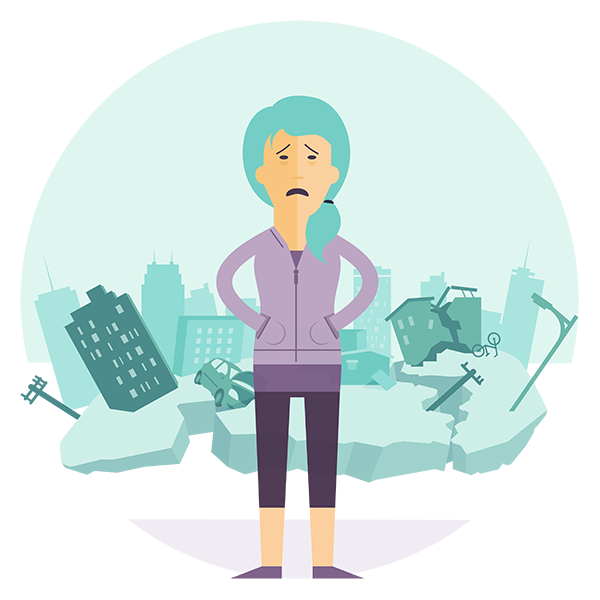
One of Hanako's deepest fears is that a big earthquake will destroy her city. She imagines that the buildings in her neighborhood will be destroyed. She won't know where her family is and she'll be all alone. She'll be surrounded by dead and injured people and she won't know what to do. A tidal wave will be on the way. She won't be able to survive!
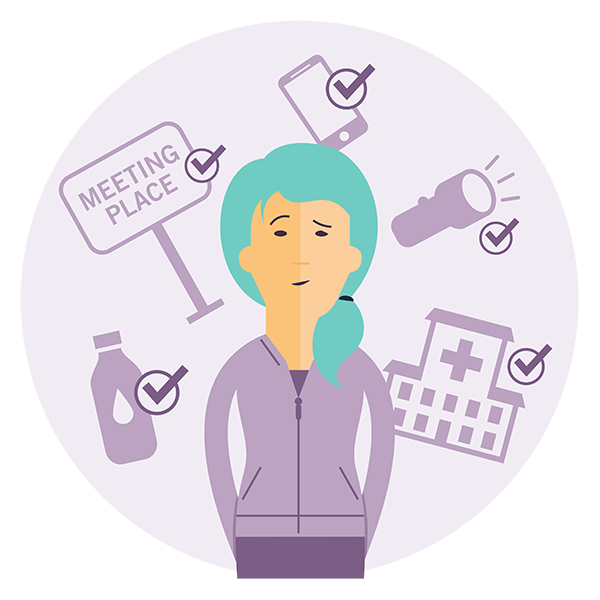
Hanako needs to make a coping plan. She knows that if "the big one" hits she can try to find her family at their meeting place. If her phone works she can try to make contact. She can check if her house is safe and get her earthquake kit. She will also check on her neighbors to make sure they are okay. She takes a moment to remember that the immediate emergency will be stressful but that she can cope and help others.
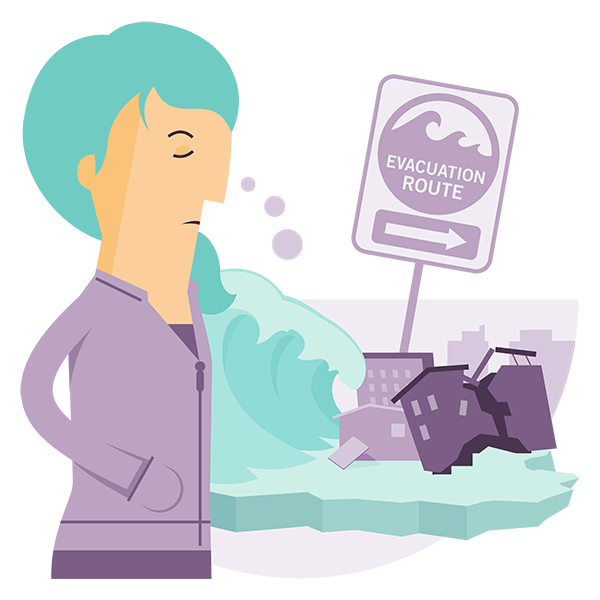
Hanako's coping plan helped her anxiety a little, but she still feels nervous. To help weaken her fear, she imagines herself in her worst case scenario. The earthquake has just happened. She's all alone and her phone isn't working. She runs up the hill to higher ground in case the tidal wave hits.
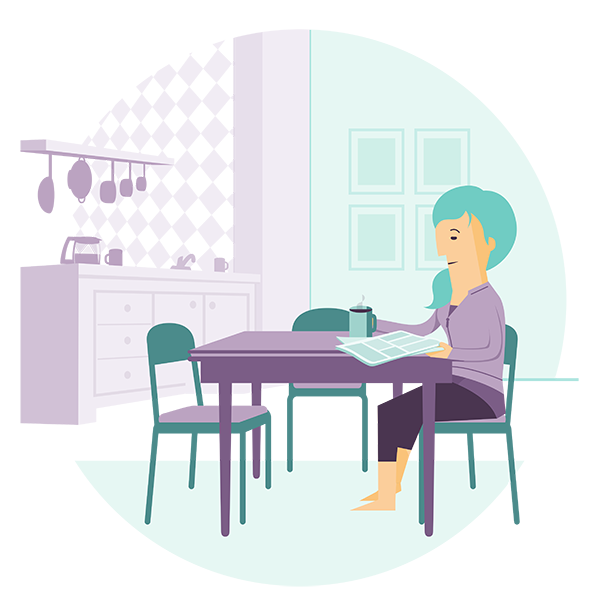
Hanako keeps focusing on her fear and how she could cope for 30 minutes a day. With time and practice her fear of a big earthquake becomes less intense. She can now read the news without worrying it will trigger her fear.
Good job! You’ve Created a Coping Plan
Download Your Worksheet
Good job! You've learned that the key to overcoming your worries is to face them, not avoid them. It's important to remember that worries come and go. They aren’t under your control and can pop into your head at any time. But you can learn to respond to them in a new way! Practice writing, reading and visualizing your worst-case scenario and coping plan. Try it for 30 minutes a day. Record your anxiety before and after. Talk to your therapist if you need help improving your plan. It might be hard at first, but learning to face your fears can help quiet the doubts and fears that keep you stuck.
Congratulations! You’re Ready to Face Your Worries
Continue making coping plans and facing your worries head on. Write them out, visualize them and focus on how you’d cope if the worst happened.
Dealing with Uncertainty
12minThe future is uncertain and filled with unexpected outcomes. When you try to predict all that could happen, your worries can get the best of you. Trying to prepare for every possible outcome can drain all your energy. If you start avoiding everything you think might be risky, you’ll miss out on life. You can learn to cope with uncertainty by gradually letting go of control. When you give it a chance, you’ll find that your fears don’t really come true or that you coped well when they did.
- The Uncertainty of Life
- Control Traps
- Letting Go
- Changing Your Behavior
! For your privacy, this site does not save what you type. To save it or have a therapist review it, please download your work at the end of your session.
Life is Uncertain
It may seem at times like the only certainty in life is that life is uncertain. Unexpected rain often reminds us how difficult it is to predict the weather. Sports games and elections sometimes end in ways no one saw coming. Uncertainty can lead to good surprises. You may get a job offer after you were sure you messed up the interview. But it can also hit you hard, like when a relationship you thought was going great suddenly fails.
You can spend a lot of time trying to control things in life. It makes sense that you want to protect the things you love and prevent bad things from happening. To boost the odds that you will be successful, you likely prepare for job interviews and exams. You probably spend time with people you love and try to make them happy to protect your relationships. But despite your best efforts you can’t control what life has in store for you. You can only influence it.
Hating the Unknown
Some people deal with uncertainty better than others. It can be hard for those who “hate” surprises. If you feel frozen or overwhelmed when things are unsure, you can start to feel more anxious. To avoid anxiety, some people put a lot of energy into trying to make things more certain. The trouble is that trying to have more control over life can lead you into traps.
Control Traps
Trying to control everything in your environment can lead you into three types of traps.
These traps aren’t exclusive. You can fall into more than one of these traps in different areas of your life.
When things are uncertain you may start worrying so much that you can't make any decisions. This happens when you get stuck in all the possibilities of what can go wrong and how you could stop it. You won't want to act until you're 100% sure of the outcome. You might feel paralyzed and end up doing nothing.
As you worry about what can go wrong, you might start doing more things to make you feel safe. For example, you might drive to your appointment a day early to make sure you know the way and where to park. These precautions can take over and drain your energy.
You may try to reduce your anxiety by only doing things that feel 100% certain. For example, you might stop meeting new people. Maybe you'll stay at your job even though you'd like to do something more interesting. Over time, you may become more and more isolated. You can end up missing a lot of what life has to offer.
Letting Go
A problem with control traps is that they stop you from learning. If you always avoid scary situations, you’ll never learn what’s really dangerous. If you work hard to make sure nothing bad happens, you may assume that your work protected you. You’ll never know if your bad prediction was ever going to come true. Maybe there was nothing to worry about!
To get out of control traps you need to slowly let go of your need for safety and control. When you let go of control, you can see if what you feared would happen actually did. And if it did, you can track how you coped with it. Over time your brain can learn that uncertainty does not always mean that there is an emergency.
Trusting You Can Cope
To test out your fears you can do what therapists call a behavioral experiment. The first step is to pick a fear that you want to test.
You might want to test what will happen if you do something you’ve been avoiding. Maybe you’ve been avoiding eating lunch with your coworkers. Perhaps you’re afraid you’ll say something dumb. To test out this fear, you could change your behavior and eat lunch with your coworkers.
You might want to test out what will happen if you stop doing something that makes you feel safe. For example, you might always sit on the aisle in the movie theatre just in case something happens. You could test out this fear by sitting one seat in. Over time you could gradually work your way to sitting in the middle of the theatre.
Remember some fears are quite legitimate. For example, breaking the law by not wearing a seatbelt is not something you want to test. If you are not sure if a test is suitable, your therapist or someone you trust may be able to help you think it through.
Start Small
You don't have to pick the scariest situation. You can start small and see what happens. Think of something that would make you a little uncomfortable. You'll see that the more you do things that stretch your comfort level the more you will begin to trust that you can cope with life's surprises.
What would you like to try this week that makes you a bit uneasy?
Obstacles and Safety Traps
Take a moment to list some of the things that might prevent you from following through on your plan.
An obstacle could be a thought like "I'll make a fool of myself." It could also be a feeling or sensation. Anxiety can make your stomach hurt or heart race. These uncomfortable physical sensations can stop you from trying new things.
Safety behaviors can also get in your way. For example, you might feel more comfortable at a party when you pretend to be busy on your phone. But this could stop you from being social and meeting new people.
What are 2 obstacles or safety traps that could keep you stuck?
Plan Ahead
It's important to think about the steps you could take to overcome your obstacles. Making a plan now will help you get past your obstacles and reach your goals. These experiments aren’t always easy so it's important to have a plan.
How could you overcome your obstacles?
Making Predictions
Now that you have a plan you’d like to test, it's time to see what a good fortune teller you are! Think about what you believe will happen when you put your plan to action. If you're right, how do you think you'll cope?
Here's the change you are planning to make:
Do What Scares You
The next step is to go out and do what you had planned. Act as if you aren’t afraid. You can compare what really happens with what you predicted. You may find that what you feared did not come true. If your prediction was right, you may find that you coped better than you thought. You should also note what you learned about your ability to cope with uncertainty. If you find this difficult, talk with your therapist or someone you trust.
Scott's Story

Scott needed to buy a present for a friend's housewarming party. He thought a plant was a nice idea, but he wasn't sure. His friend might hate it. Scott predicted that if he gave his friend the plant she'd think it was a terrible gift. She'd probably question her friendship with him and wouldn't want to hang out anymore. Scott imagined she'd laugh at him behind his back. He'd be too embarrassed to show his face again!

Even though Scott was uncertain about the plant, he decided to act as if everything would be fine. He bought the plant and brought it to the party. His friend seemed happy enough and Scott had a nice night.

A month later when Scott was visiting his friend he noticed the plant he'd bought was dead and in the garbage. He'd been right that a plant wasn't a good gift! His friend had killed it in just a few weeks. He felt ashamed and embarrassed.
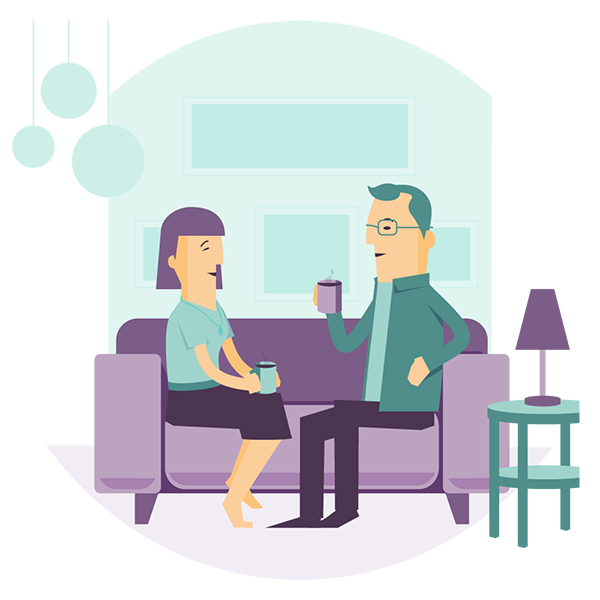
But then Scott realized that his entire prediction hadn't come true. Even though the plant was a bust, his friend had still invited him over. They chatted and hung out just like always. Nothing had changed between them. His friend even apologized for killing the plant. She was so embarrassed! In the end, Scott realized that his fear had been too much. He hadn't picked the best gift for his friend, but it didn't destroy their friendship.
Good job! You've Got an Experiment to Try
Download Your Worksheet
Good job! You've learned how you can cope better with the unknown. Now that you've chosen a fear you'd like to test, it's time to go out there and give it a try. Download your worksheet and compare what really happens versus your predictions. Share your experience with your therapist or healthcare provider.
Congratulations! You're Learning to Cope with Uncertainty
Over the next few weeks, you can redo this unit and try things that are even more difficult. Over time, you will become more confident that you can cope even when things are uncertain.
Core Beliefs
16minWe all have beliefs about ourselves, others and the world that we have held for a long time. These underlying beliefs can affect how we interpret our lives. If you hold a negative core belief you may have a habit of only noticing what fits in with it. This bias can get in the way of thought challenging. No matter how hard you work at it, your mood might crash whenever specific thoughts appear. To continue working through your depression or anxiety, you need to tackle your core beliefs. In this unit, you’ll learn how to break apart your core beliefs and start seeing the world from a different angle.
- Identify a Core Belief
- Find Evidence
- Balance Your Belief
- Daily Reinforcement
! For your privacy, this site does not save what you type. To save it or have a therapist review it, please download your work at the end of your session.
Trapped by Core Beliefs
If you’ve been challenging your negative thoughts for a while, you’ve probably become quite good at it. It should be easier to review your thoughts and come up with something more balanced.
However, you may notice that some thoughts are still getting you down, despite your hard work. It may seem like you can’t shake them, no matter how much challenging you do.
Your problematic thoughts probably fall under a general theme. Are they all about being unlikeable? Maybe they revolve around being unsafe. If this is the case, a core belief is likely keeping you stuck.
Core beliefs are more than just a group of thoughts. They are deep-rooted ideas or assumptions about yourself, others and the world. Core beliefs tend to be rigid and not easily broken down. To overcome your anxiety or depression, you need to rework your core beliefs.
Fundamental and Powerful
You may wonder how your core beliefs formed in the first place. Where did they come from? Core beliefs are created through your life experience. When you are young, what you see, hear, and do, gets interpreted into rigid laws and rules about the world. For example, say school was hard as a child, and you got a lot of criticism or negative feedback. This experience could lead to a global belief like “I’m stupid.”
Core beliefs, as the name suggests, tend to be central and fundamental. In fact, at their root, core beliefs focus on our ability to survive. They often fall into these categories: safety, likability, and capability. Being safe and a valued member of your community can mean life or death. From an evolutionary perspective, it’s no wonder that core beliefs are so emotionally powerful!
Let’s explore the categories of core beliefs a bit further. Core beliefs about safety may be something like “I’m helpless,” or “The world is a dangerous place.” For likability, you may hold beliefs like “I’m unlovable,” “I’m a bad person,” or “People are judgmental.” Finally, in the capability category, you may find the beliefs “I’m incompetent,” or “It’s a dog-eat-dog world.” A core belief may fit into more than one category at a time. What they all have in common is the suggestion that you won’t prevail. There is something that may prevent you from surviving in our world.
To protect against this threat, many people cope by creating conditions or rules. You may tell yourself “I’ll be safe as long as I’m in control,” or “I’m lovable if I can make everyone happy all the time.” You might try to live by the rule that “I’m competent as long as I don’t make any mistakes.” As you can see, these conditions tend to be nearly impossible to uphold. No one is immune from making mistakes! How can you keep everyone happy all the time? It’s only natural that you’ll eventually “fail” at maintaining these impossible standards. When this happens, your core belief is exposed, and your anxiety or depression can get even worse.
The Selective Brain
Think back to a time when you had an argument or debate with someone, say about politics. Did it seem like facts didn’t matter? Like nothing was going to change your friend’s mind? You were probably left wondering how your friend could completely ignore the side of the story that doesn’t fit with their political view. The same thing happens with core beliefs. It’s not just your friend, we all have selective brains!
Imagine your mind as a house. Your core beliefs come first. They are the foundation or bedrock of the whole building. When you experience something, your brain takes in all the pieces that fit with your core belief. These experiences add bricks and walls to the house. What doesn’t match the foundation is ignored and left out. In a sense, the human brain takes shortcuts. It’s easier to cast aside experiences that don’t fit into our core beliefs than it is to tear down the house and rebuild from scratch.
The selective power of the human mind ensures that core beliefs are always reaffirmed. The connections in your brain relating to your core beliefs are very strong. Reworking a core belief means you’ll need to look out for the experiences your mind tends to ignore. You need to offset the selective nature of your brain. It’s not easy, but you can do it.
Find a Core Belief
The first step to challenging a core belief is to identify one. This task may not be so easy. You may find you see the rooms and windows of the house but not the foundation. If that's the case, it may help to work in reverse. Start by writing down a common negative thought. Then ask yourself, "What does this say about me? Or others? Or the world?" Keep doing this exercise until you reach the central idea, your core belief.
Keep in mind that core beliefs tend to fall into the categories of safety, likability, and capability. It may also help to think of a core belief as a statement starting with "I am...," "People are...," or "The world is...." Other core beliefs may start with "God is…," "My life is…," or "The universe is…"
Start with a problematic negative thought and work down to your core belief.

What does this say about you, others, or the world?

What does this say about you, others, or the world?

What does this say about you, others, or the world?
Challenge your Belief
Once you've identified a core belief, you can start to challenge it. Remember that your brain is selective. It has a habit of only letting in the experiences that fit with your core belief. For this reason, it may be hard to find evidence that shows that your core belief is not true. You may need to work at it. If you are feeling stuck, there are a few things you can try. You can ask friends or family members for help or think about recent activities you've done. It may also help to look at examples in your thought diary.
Here's your core belief:
positive_belief
What evidence do you have that your core belief is not completely true? Include everything you can think of even if it seems too small to mention.
Balanced Beliefs
Similar to thought challenging, the key to reworking a core belief isn’t to make it 100% positive. You need to create a balanced belief. Pretending that life is all sunshine and rainbows won’t help. You need a belief that is realistic. It should capture both the negatives and the positives about yourself, others or the world.
Here are some examples comparing negative, positive, and balanced core beliefs:
| Negative Belief | Positive Belief | Balanced Belief |
|---|---|---|
| I am useless. | I am competent at everything. | I can do certain things well, but not everything. I make mistakes sometimes, but I am also able to learn from them. |
| Nobody loves me. | Everybody loves me. | I have a few good people in my life that love me. |
| The world is better off without me. | I am a really important part of this world! | While my existence might not be important to the world at large, I do my best to help out my community. The people I connect with are happy I am in their lives. |
Your Balanced Core Belief
Take a look at your evidence that does not support your core belief:
text-5
Use this evidence to help you make a new balanced core belief. If you’re feeling stuck, don’t worry. Reworking core beliefs can be tricky and your therapist can help you get the hang of it.
Boost Your Belief
Creating a balanced core belief is a good step forward, but you won’t feel real change until you reinforce it. Remember that your brain is selective and ignores information. Just writing down a new balanced belief won’t be enough to change your thinking. You need to start doing little things every day to strengthen it.
Start by writing down experiences each day that support your new belief. Keep a diary or notebook. This exercise will help you notice what your brain tends to dismiss. You don’t need big events! Small things count. A conversation or minor situation can be good evidence for your new belief.
Don't Sweat It
Some people worry when new evidence for their old belief comes up. You might panic and think that your old belief was right after all. The truth is, life happens, and sometimes things won’t go your way. Your new core belief is balanced and includes the positive and negative. Evidence that supports your old belief doesn’t automatically oppose your new one. In fact, finding the negative has never been the problem! Nobody is perfect, and that’s not the goal. Try not to sweat it and keep working on finding evidence that supports your new balanced belief.
Adeline's Story
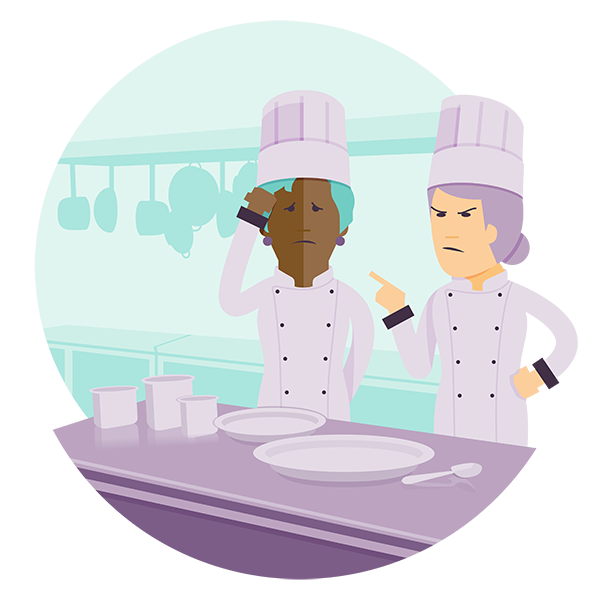
Adeline always believed that if she had a good job, she was a success. At her work, she was able to climb the ranks until finally reaching her dream job as a sous chef. Unfortunately, after a few months, Adeline's boss told her it wasn't working out. Out of work, Adeline felt her world crashing down and became depressed.
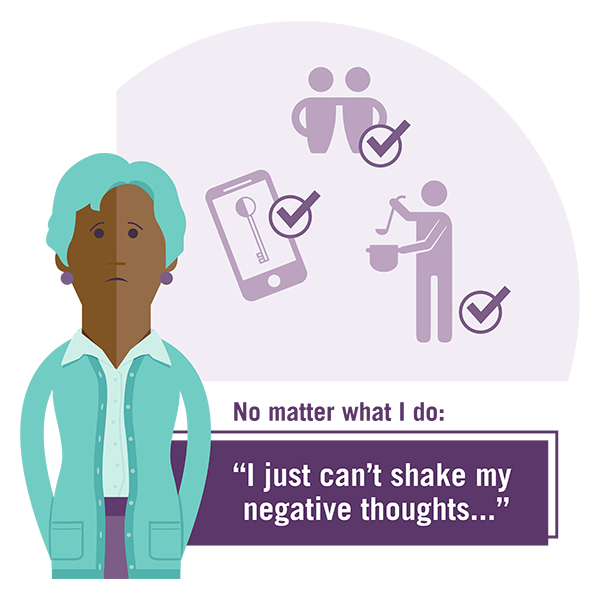
Adeline began to work through her depression with the help of a therapist. She started to reconnect with friends and challenge her negative thoughts. She also got a position volunteering at a soup kitchen. On the outside, everything seemed to be going well. But despite her hard work, Adeline's mood still plummeted every time she made a mistake. It was as though some thoughts were too strong to challenge away.
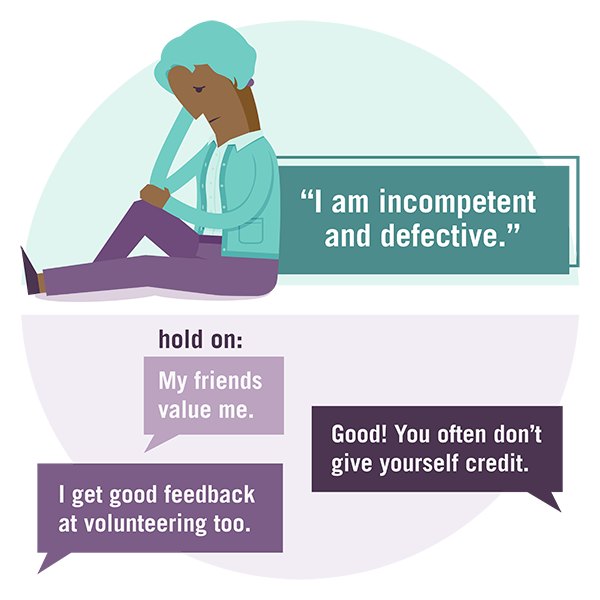
Today, Adeline and her therapist work through her thoughts and identify a core belief. "I am incompetent and defective." They begin to look for evidence that this belief is not true. Adeline points out that she is valued and trusted by her friends. She also notes that she gets good feedback when volunteering. Adeline's therapist agrees with this evidence and suggests there is more. He reminds Adeline that she doesn't usually give herself credit for what she does well.
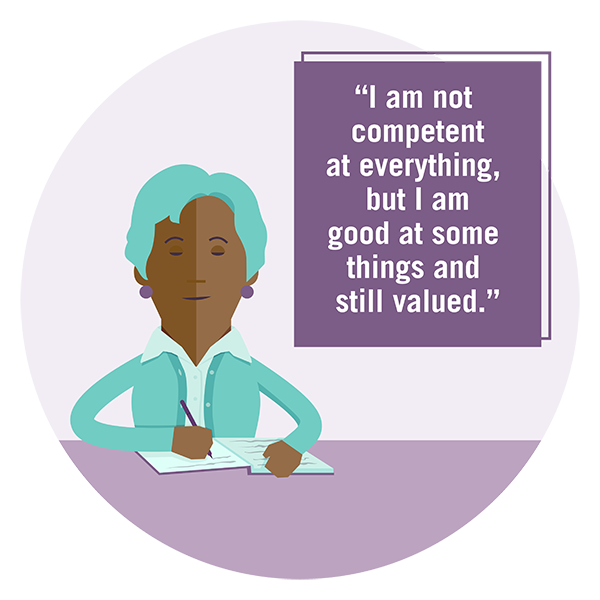
Adeline and her therapist develop a new balanced belief. To help reinforce it, Adeline keeps a diary. She writes down little things that happened each day that support her new belief. This exercise helps her notice the daily achievements she was ignoring. It also stops Adeline from discrediting her abilities. A few months later, Adeline is still hard on herself when she makes a mistake. But her mood doesn't crash. She's able to see that one mistake doesn't define her.
Good Job! You've Started Working on a Core Belief
Download Your Worksheet
Good job! You’ve learned about core beliefs and how to reframe them. Remember that core beliefs are deeply ingrained and will take time to break down. Keep working on your new balanced belief with your therapist. Record evidence that supports your new belief every day to help strengthen it. A diary of positive experiences can be handy to look on back on if your original core belief creeps up.
Congratulations! You’ve Begun to Rework a Core Belief
Continue identifying core beliefs and reworking them. Create new balanced beliefs and reinforce them with daily evidence. If you’re feeling stuck, you can review this unit or talk to your therapist or healthcare provider.
Relaxation
15minWhen you become anxious, your body gets ready for conflict. You breathe faster and shallower to take in more oxygen. Your muscles tense as your body gets ready to fight or run. When you are worried about something that might happen in the future, your body can stay tense for a long time. This can make your muscles hurt and feel sore. You may end up feeling exhausted and more anxious. Learning to relax can help you break this vicious cycle. You need to give your body and mind a rest.
- The Skill of Relaxation
- Deep Breathing
- Progressive Muscle Relaxation
- Overcoming Obstacles
! For your privacy, this site does not save what you type. To save it or have a therapist review it, please download your work at the end of your session.
Muscle Overdrive
If you came face to face with a wild animal, your body would get ready to either fight or run away. You would start breathing faster and your heart would start pumping like crazy. Your muscles would tense up, like a sprinter getting ready to run. When the danger was over, and you’d escaped, your body would calm down and go back to normal.
When you’re worried about something, your body gets ready in the same way. The difference is that you aren’t in danger. There’s no wild animal in front of you. Instead, your body is preparing itself for a wild animal that you might confront some time in the future. Because you can’t escape from a “what if”, your body doesn’t get to calm down and relax. You can stay ready for danger for a long time and send your muscles into overdrive. Learning to relax can help you give your body and mind some rest.
Relaxation as a Skill
Some people think that relaxation should be a natural process. “I’ll just sit down on the couch, turn on the TV, and do nothing.” But you might find that relaxing is actually harder than you think. Some people find that their worries take over when they try to relax. They might even feel guilty that they aren’t doing errands or taking care of things.
Learning to relax is a skill. It might not be enough to just distract yourself with a TV show or a hobby. Instead, you might need to practice specific ways to focus on relaxation. These techniques can help give you a break from the way anxiety affects your body. They can also teach you how to deal with worries that might come up when you’re relaxing.
When to Relax
A lot of people think you should relax when you are very anxious. But it’s really hard to relax when you are at the height of panic or worry. In fact, research shows that trying to relax during these stressful moments doesn’t work. It can actually make your anxiety worse!
Relaxation is not good for emergencies. You can’t relax away the intense physical symptoms of anxiety. Instead, you should practice relaxation regularly at times when your anxiety is under control. Make it part of your self care routine. With practice you can do relaxation exercises throughout your day. You can practice on the bus, at work or before you go to bed.
Types of Relaxation
There are lots of different ways to relax. Some focus on your breathing, others focus on your muscles. You might find that some techniques work better than others. Everyone is different. What works well for you might not work at all for someone else.
We’ll focus on two different ways to relax: Deep Breathing and Progressive Muscle Relaxation.
Deep Breathing
Babies breathe in a slow and deep way. As life becomes more stressful, people’s breaths tend to get quicker and shallower. This becomes a habit unless people learn to revert back to deep breathing. Some people master how to do this when they learn to sing or do yoga.
You can check your own breathing style by placing one hand on your chest and the other on your stomach. When you breathe in, notice which part of your body rises the most. If it’s your chest, focus on slowing down and deepening your breath. You want to arrive at the point where your stomach expands, but your chest barely rises. You also want to aim for about 8 seconds between in-breaths. Make sure to also slow down your out-breath to about 4 seconds.
Practicing Deep Breathing
You can practice deep breathing anywhere! It’s invisible to the people around you. You can practice while waiting in line, on the train or at the movies.
In the beginning, you can practice deep breathing for only 5 minutes at a time. As you progress, you can start using it anytime and anywhere you have a few moments to spare.
You can also use this technique when you notice that your breathing has become fast or shallow. Slowing your breathing sends a message to your brain that there is no danger. This allows your body to take a break and can reduce your fatigue over time.
Progressive Muscle Relaxation
This relaxation technique focuses on your muscles. The idea is to squeeze your muscles tight and then relax them. It might sound strange to tense up your muscles first, but this can make the relaxation feel deeper. Think of it working like a rubber band. The more you pull it tight in one direction, the further it snaps back in the opposite direction.
Progressive muscle relaxation can help you become more aware of your body. People often keep their muscles tight without noticing it. You might be tense even when you aren’t worrying! As you practice relaxation you’ll get better at recognizing the state of your muscles. Once you notice your anxiety and tension building up during the day, you can take steps to relieve it.
Practicing Muscle Relaxation
There are many different muscle groups where you may store tension. You shouldn’t try to squeeze all the muscles in your body at once! To do progressive muscle relaxation you need to work through the muscle groups one at a time. You can do it in any order. We’ll start from the head down to the toes.
Facial Muscles
Forehead
To tense the muscles in your forehead, lift your eyebrows up as much as you can. This should cause your forehead to wrinkle. Feel the tension in your forehead and scalp. Hold it for 5 seconds, then let go. Notice how the muscles relax when your eyebrows drop.
Eyes
Close your eyes and squint them as much as you can. At the same time, wrinkle your nose. Focus on the tension around your eyes, nose, and cheeks. Hold it for 5 seconds. Then stop squinting and wrinkling your nose, while keeping your eyes closed. Feel how the muscles around your eyes, nose, and cheeks relax.
Jaw
Make a big grin and clench your teeth. Also draw your mouth and chin inward. You should feel your mouth, jaw, and neck tense. Hold it for 5 seconds, then let go. Focus on how your jaw muscles and neck muscles relax.
Practicing Muscle Relaxation
Upper Body Muscles
Shoulders
Move your elbows up and back so that your shoulder blades gets pushed together. Focus on the tension this creates in your shoulders and back. Hold the tension for 5 seconds. Then relax your elbows and shoulders and focus on the relaxed feeling in your shoulders and back.
Chest
Take a deep breath and hold it in by tightening your chest. Focus on the tension in your chest as you pull it in. Hold the tension for 5 seconds. Then breathe out slow and focus on the looseness of the chest muscles.
Upper arm
Start with your dominant arm. Tense your bicep while keeping your forearm relaxed. You could also press your bicep into the side of your body. Focus on the tension in your upper arm. Hold the tension for 5 seconds. Then relax your arm and focus on the relaxed feeling in your upper arm. Now repeat this with your other arm.
Lower arm
Start with your dominant arm. Tense your forearm as much as you can. Make a tight fist. Keep your upper arm relaxed. If you have arthritis in your hands, make sure you do not keep your fist so tight that it hurts. Also if you have long fingernails, do not dig them into your hands. Focus on the tension in your hand and forearm. Hold the tension for 5 seconds. Then relax your forearm and hand and focus on the relaxed feeling in these body parts. Now repeat this with your other arm.
Stomach
Tighten your stomach muscles. Make them as hard as possible. Focus on the tenseness of these muscles. Hold the tension for 5 seconds. Then relax your stomach muscles and focus on how they change from tense to relaxed.
Practicing Muscle Relaxation
Lower Body Muscles
Buttocks and Thigh Muscles
Tighten your buttocks by squeezing them together as much as you can. Focus on the tension in your gluteal and thigh muscles. Hold the tension for 5 seconds. Stop squeezing your muscles together. Focus on the relaxed feeling in your gluteal and thigh muscles.
Calves
Start with your dominant leg. Lift your foot off the floor and point your foot. Tighten your lower leg. Focus on the tension in your foot and calf muscle. Hold the tension for 5 seconds. Then return your foot to the floor and focus on the relaxed feeling in your calf and foot. Now repeat this with your other leg.
Shins
Start with your dominant leg. Lift your foot off the floor and flex your foot. Tighten your lower leg. Focus on the tension in your foot and shin muscles. Hold the tension for 5 seconds. Then return your foot to the floor and focus on the relaxed feeling in your shin muscles and foot. Now repeat this with your other leg.
Overcoming Obtacles
Obstacles to relaxation vary from person to person. But some are pretty common. We’ve got a few tips to help you:
If you have an injury or feel pain for any reason, don't squeeze your muscles too hard. Pain will make your muscles tense up, making it hard to relax. If an area really hurts, skip making it tense and try to relax it directly.
While trying to relax, you may become distracted by worries. Don't try to argue with your worries or push them aside. This will only distract you more. The best approach is to bring your attention back to the relaxation exercise.
If you don't find deep breathing or progressive muscle relaxation effective, don't worry. There are other ways to relax. Ask your therapist for advice.
If you find it hard to stay awake during a relaxation exercise, try sitting up instead of lying down. It can also help to do your relaxation earlier in the day. It's easy to fall asleep if you do your exercise right before bed.
Try a Relaxation Exercise
It’s time to try relaxing! Many people find it useful to follow an audio recording. Everyone does relaxation a little different, so you might prefer some recordings to others. Try them out and see which ones you like.
Dr. Lori Brotto guides you through a body scan focusing on acceptance and awareness. This mindfulness exercise will take about 40 minutes.
Sean Butler leads you through a progressive muscle relaxation exercise. You can complete this practice in just over 11 minutes.
Dr. Theo DeGagne presents Quietude, with music by George Blondheim. This guide takes you through breathing relaxation, deep relaxation, and visualization. This exercise will take you about 20 minutes.
Flora Lung presents Beautiful Beach, a guided imagery relaxation exercise. This exercise is in Cantonese and will take about 20 minutes.
Flora Lung 提供一個啟導式想像鬆弛練習 ----- 美麗的海灘。練習以粵語進行,需時約20分鐘。
Poran Poregbal leads you through a body and mind relaxation guide. You will focus on your breathing, heartbeat, mind and sensations. This exercise is in Farsi and will take about 10 minutes.
پوران پوراقبال راهنمای شما میشود در یک تمرین آرامش یابی بدن - ذهن. شما تمرکز میکنید بر تنفس، ضربان قلب، و هیجانات ذهنی. این تمرین به زبان فارسی است و ۱۰ دقیقه به طول میانجامد
Andrea presents Safe Place, a guided visualization that promotes feelings of safety and comfort. This visualization is in Spanish and will take about 5 minutes.
Andrea presenta Lugar Seguro, una visualización guiada que promueve sentir seguridad y comodidad. Esta visualización es en Español y toma aproximadamente 5 minutos.
Good job! Time to Make Relaxation a Habit
Download Your Worksheet
Good job! You've learned how you can use relaxation to give your body a rest. Relaxation is a skill and the more you practice it, the more effective it may become. We have included a worksheet to record your daily practice of relaxation. Download your worksheet and record your practice for the next week. Share your experience with your therapist or healthcare provider.
Congratulations! You're Learning to Relax
Keep practicing deep breathing and progressive muscle relaxation. You can revisit this unit to try out different recordings and see which ones you prefer. With practice you will get better at noticing tension in your body. Over time, relaxation will become an important part of your daily self-care.
Problem Solving
10minIt’s easy to feel overwhelmed when facing a problem like losing your job or a close friend. When you have a problem, changing your thoughts is not the goal; you need to change your situation. In this unit, you will learn how to work through your problems and generate solutions. Take control and create a plan. Even at the worst of times, a good plan will help you get through it.
- Naming the Problem
- Brainstorming Solutions
- Making a Choice
- Taking Action
! For your privacy, this site does not save what you type. To save it or have a therapist review it, please download your work at the end of your session.
Plan to Action
Problem-solving plans are the key to helping you face life’s challenges, big or small. Ignoring your problems doesn’t make them go away — it gives them time to get bigger. Instead, take action and make a plan to help you break down your problem and solve it once and for all. Your plan will also help boost your confidence. When you trust that you can handle whatever life throws at you, you’ll worry less and feel better.
Name the Problem
So how do you make a problem-solving plan? The first step is naming the problem. It’s important to make sure you are dealing with a problem and not a worry. Worries focus on something that might happen. They usually start with the words "what if." Problems are happening right now or about to happen very soon. If you aren’t sure if you have a worry or a problem, ask yourself if it’s already happened. If the answer is yes, you’ve got a problem.
Name the problem. What's going on?
Brainstorm
Once you’ve named your problem, it’s time to brainstorm possible solutions. Try to think up a few ways that you could solve your problem. It’s important not to censor yourself. Write down all your options, even if some seem silly. Sometimes the most ridiculous thought can lead you to the best solution.
If you're feeling stuck, try brainstorming with someone else. Your therapist, a good friend, or a family member can help you come up with ideas.
Try brainstorming three solutions to your problem:
Pros and Cons
Take a look at the different options you came up with to solve your problem. What are the upsides and downsides for each possible solution? For example, if you lost your job you might consider going back to school. An upside could be that it would lead to better job opportunities. The downside could be that tuition is expensive.
What are the benefits of each of your solutions? What are the drawbacks?
| Possible Solution | |
|---|---|
| Possible Solution: 1. | |
| Possible Solution: 2. | |
| Possible Solution: 3. |
Make a Choice
The upsides and downsides of each solution can help you decide what to try first. Take a look at each of your possible solutions and rank them in terms of which you should try first, second and third. There’s no perfect way to rank your solutions. A solution could be ranked first because it’s easy to do, has the fewest downsides or seems the least risky.
Take a minute to order your possible solutions 1, 2, or 3. Which would you like to try first?
| Possible Solution | Order | |
|---|---|---|
| Possible Solution: 1. | ||
| Possible Solution: 2. | ||
| Possible Solution: 3. |
Give it a Try
Now it’s time to give your solution a try! If it doesn’t solve your problem, try another solution on your list or brainstorm some new ones. Depending on the nature of your problem, you might be able to try a few ideas at the same time. For example, if you were looking for a new job you might try a few things right away. You could let your friends know you’re looking, send your resume to a few companies and register with a headhunting agency.
Vijay's Story
Don’t remove
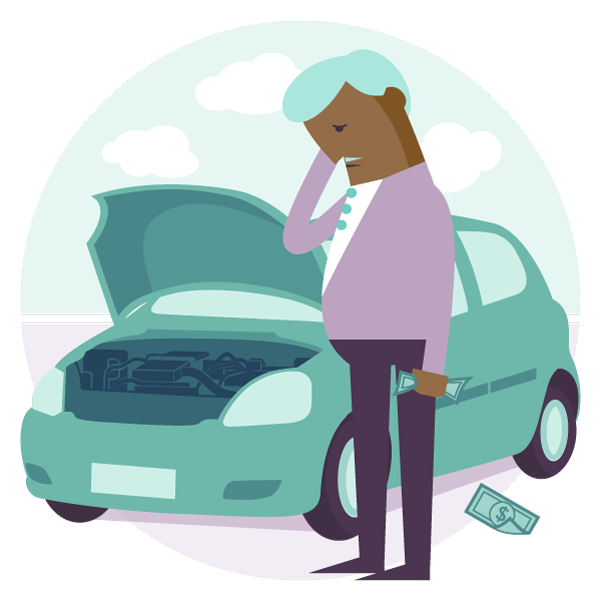
Vijay was having a terrible day. Work was busy and he was running late. Everything came to a head when he got into his car and it wouldn’t start. Great. Money was already tight this month. Vijay didn’t know how he’d afford to get the car fixed, and still be able to pay his mortgage and buy groceries. With help from his therapist, Vijay needed to come up with a plan to save money for this month’s expenses.
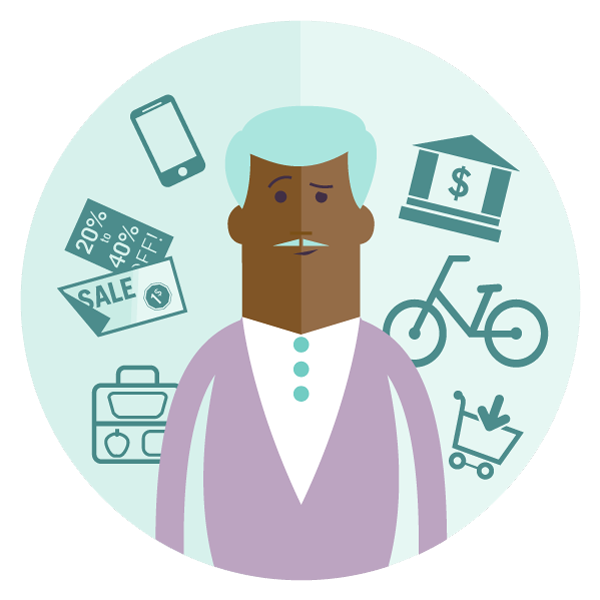
Vijay started to brainstorm some ideas. He could ask creditors to skip a payment or borrow money from family or friends. Packing a lunch for work instead of eating-out could save some cash. He could rent out the basement or sell some things online. He was sure he could find a cheaper cell phone plan and ride his bike to work. He even considered delivering flyers in the evenings, like he did when he was a teenager.

Vijay considered his options. He didn’t want to ask anyone for money. But then he remembered that his brother owed him $200 for a present they bought for their parents. He didn’t mind asking for that back, and his brother apologized for forgetting. Finding a cheaper cell phone plan was easy, but Vijay didn't want to rent out the basement. He saved more money than he expected by bringing lunch to work.

When it all added up, Vijay was able to buy groceries and make his mortgage payment! He was thrilled with what he’d managed to save over the month. He decided to keep up some of the changes to build up a cushion for the next emergency.
Your Game Plan
Download Your Worksheet
Good job! You’ve got a solution to your problem that you’re ready to try out. If it’s not effective, you’ve got a few backups ready to go. It’s helpful to fine tune your plan with your therapist and keep track of how well your solutions work out. Remember that having a solid plan can help you solve your problems. When you have fewer problems you'll have less stress and more confidence. This will make you feel better and boost your mood. Download this worksheet to save a copy of your plan and keep track of your progress.
Great Work! You’ve created a plan to solve your problem.
Remember that making a problem-solving plan will help you cope with life’s ups and downs. The steps are simple:
- Name the problem
- Brainstorm possible solutions
- List the upsides and downsides of each solution and rank them
- Test a solution
- Evaluate the outcome
Thought Challenging
20minFew things in life are as important as talking to yourself kindly. If you want to achieve a goal or live a happy life, you need to talk to yourself like you are your own best friend. It’s hard to stay motivated or positive if we are too critical or feeling hopeless about a situation. When everything feels like too much, negative thinking can become routine and get in your way. In this unit, you’ll learn how to break the cycle and challenge the thoughts that keep you down.
- Keep a Thought Diary
- Track Unhelpful Thoughts
- Find Evidence
- Balance Your Thoughts
! For your privacy, this site does not save what you type. To save it or have a therapist review it, please download your work at the end of your session.
Different Perspectives
Most people believe their feelings are the result of what happens to them. If you failed a test, had a fight with your best friend, or you lost your wallet — you’re going to feel bad, right? But not everyone will react the same way, even in a tough situation. Thoughts like “I’m such an idiot” will make you feel worse, while thoughts like “I’ll do better next time” will make you feel a bit better. In the end, it’s our thoughts about things or events, not our situation, that determine how we feel.
Why Challenge Thoughts?
When you’re worrying or feeling down, most people will tell you to “let it go.” The problem is that’s easier said than done! The only way to let go of an unhelpful thought is to challenge it enough that you no longer believe it. If you try to force yourself to think, “It’s all going to be okay,” when you don’t believe it, you’ll feel worse.
Keep a Thought Diary
Sometimes, thoughts can come so quickly that you don’t notice them. The best way to track these sneaky thoughts is to keep a thought diary. Act like a detective. Keep track of the feelings and thoughts you experience in specific situations. It is important to track the strength of your feelings too. Your therapist can help you identify some of your unhelpful thoughts if you are feeling stuck.
A thought diary looks something like this:
| What was happening? | Feeling and Strength | Thoughts |
|---|---|---|
| I was sitting on the couch watching TV. | Sad → 60% Anxious → 40% Disappointed → 80% |
“Will I ever get better?” “What’s wrong with me?” |
Start a Diary
Pick a situation that is troubling you right now. It may be something that just happened a moment ago. It could be something that happened in the past but still continues to bother or worry you.
What was happening?
Remember that the situation doesn't have to be the cause of your feelings. Sometimes an event causes a big reaction, like getting fired. Other times your feelings and thoughts aren't related to what you're doing. Like if you started to cry while taking a shower. You can use a thought diary for any type of situation.
Your Feelings
How do you feel right now when you think about that situation?
If it is a past event, don’t try to remember how you felt then. How do you feel at this moment when you reflect on the situation?
Select up to 5 feelings:
Rate Your Feelings
Now rate how strong your feelings are from 0-10. Remember to focus on the feelings you have right now, not during the event.
We’ll keep track of how strong your feelings are after challenging your thoughts too. This will help us see if the exercise is helpful.
Your Thoughts
What is going through your mind right now when you think about this situation?
If you’re feeling stuck, ask yourself these questions:
What does this say about me? My future? Why does this situation feel difficult? What does this say about others?
Keep Using your Diary
Good job! You’ve started to use a thought diary.
Just recording your situations, feelings and thoughts can take practice. It’s okay if you don’t feel ready to start challenging your thoughts. Keep practicing with your therapist and come back when you’re ready.
If you’ve got the hang of keeping a thought diary then it’s time to start challenging your thoughts. Keep going!
Pick the Most Unhelpful Thought
It’s common to have many thoughts about a situation. Pick the thought that causes the most trouble, anxiety or sadness. You’ll work on challenging this one thought for the rest of the exercise.
Sometimes thoughts don’t work well in thought challenging. Use these tips to pick a suitable thought:
Make sure your thought is connected to one of your feelings about the situation. If the thought makes you feel sad, angry or some other emotion, it's a good thought to choose.
Choose a thought that is testable. If your thought starts with “What if” then you can't prove it true or false. These thoughts are not good for thought challenging.
Here are your thoughts. Which would you like to challenge?
Rewrite the thought you’d like to challenge and “let go” of.
Evidence for the Unhelpful Thought
Do you have any evidence that your thought is true? For example, if your thought is “Jim is mad at me,” your evidence might be that he didn’t return your call. Maybe the email he wrote you seemed cold.
People sometimes realize that they can’t find any proof to support their unhelpful thought. You might think it, but there are no facts that make it true! That makes it easier to let it go.
What evidence do you have that your unhelpful thought is true?
Challenge the Thought
It is almost impossible to let go of a thought if you still believe it! The best way to get rid of a thought is to challenge it until you don’t believe it anymore. To challenge a thought, you must find evidence that disagrees with it. Play devil’s advocate. Look for proof that your unhelpful thought is false or just not completely true.
For example, let’s go back to the thought “Jim is mad at me.” Evidence against this thought could be that Jim smiled at me while saying hello this morning. Sometimes his emails come off as cold when he’s busy.
Challenge your Unhelpful Thought
Here's your unhelpful thought:
What evidence do you have that this thought is not completely true? Include everything you can think of even if it seems too small to mention.
Balanced or Helpful Thoughts
Forcing yourself to think happy thoughts won’t make you feel better. If you don’t believe a positive thought is true, it could make you feel worse. The trick to feeling better is to find a balanced or helpful thought. These thoughts take both the positive and negative evidence into account. Balanced thoughts are more encouraging and supportive than positive thoughts.
Here are some examples comparing positive versus helpful thoughts:
| Positive Thoughts | Balanced or Helpful Thoughts |
|---|---|
| I’m a great friend. | I’m not perfect but I am a good friend. I may not always be there for my friends, but I know that this will get better as my mood improves. |
| I can do anything if I put my mind to it – including getting over my problems! | It might take some practice, but I feel a little more hopeful that I can feel better by changing how I talk to myself. |
| Everybody in my life is supportive and helpful. | I’m getting better at knowing who to count on in my life. I’m not 100% confident, but I’m willing to practice trusting a few people who I think are nice. |
Your Balanced Thought
Take a look at your positive and negative evidence:
Use this evidence to help you make a new balanced thought. If you’re feeling stuck, don’t worry. Balanced thinking can be tricky and your therapist can help you get the hang of it.
Re-rate Your Feelings
Now that you have worked on your balanced thought, take a moment to re-rate your mood. We can compare the strength of your feelings before and after thought challenging. A drop of at least 2 or 3 points in at least one of your emotions tells us that the exercise was helpful.
Practice Makes Perfect
Thought challenging is one of the harder things to learn in cognitive therapy. Remember that it does get easier with practice and help from your therapist. Most people find after practicing 50 or more times that they have fewer unhelpful thoughts. Also, balanced thinking becomes more automatic. Challenging your thoughts 50 times might seem like a lot, but you’ll get faster at it the more you practice.
Sean's Story
Don’t remove
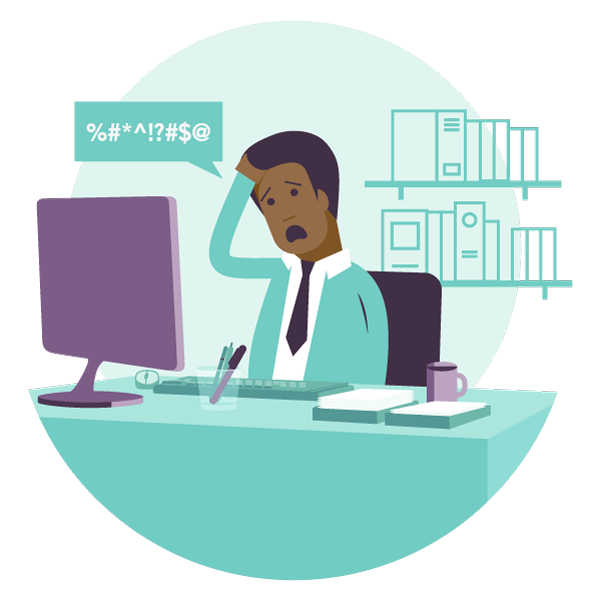
Sean was finishing up his day at work when he realized that he made a typo in a company-wide memo. He always proof-reads his emails before sending and couldn’t believe he’d missed such an obvious error.
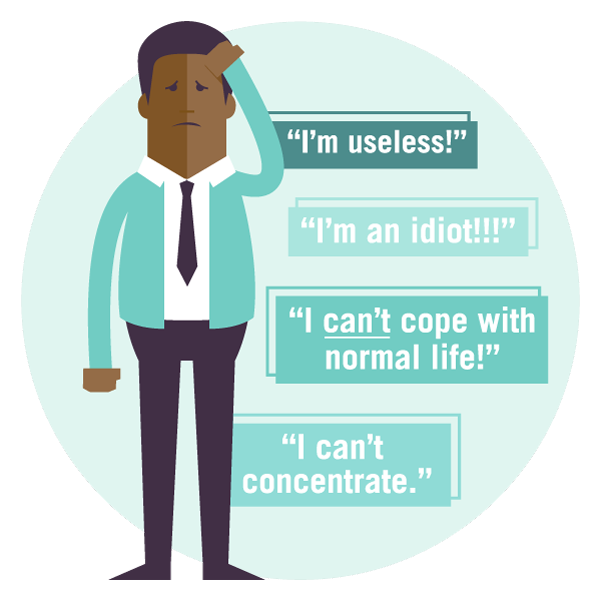
Sean’s emotions started spiralling. He felt embarrassed, angry, irritated and ashamed. “I can’t cope with normal life,” Sean thought. “I’m such an idiot. I can’t concentrate!”
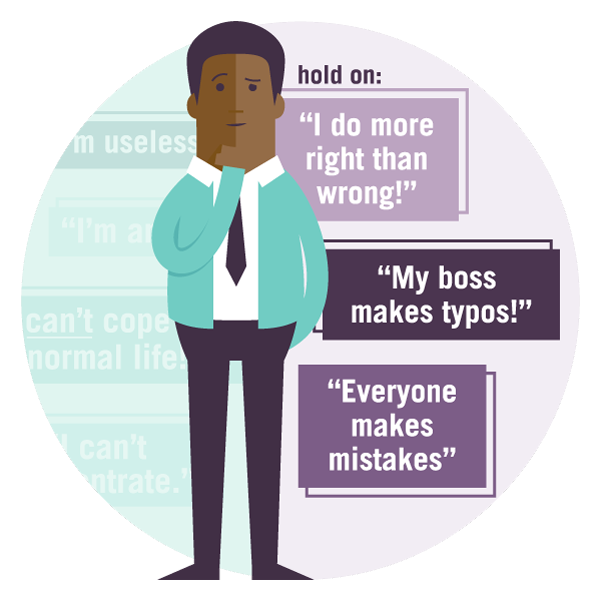
But hold on! Sean began to challenge his unhelpful thoughts. He reminded himself “Everybody makes mistakes; even my boss makes typos sometimes.” He noted that “If co-workers tease me, I can handle it.” And finally, “I’m not an idiot because I just finished a big project that was very successful.”
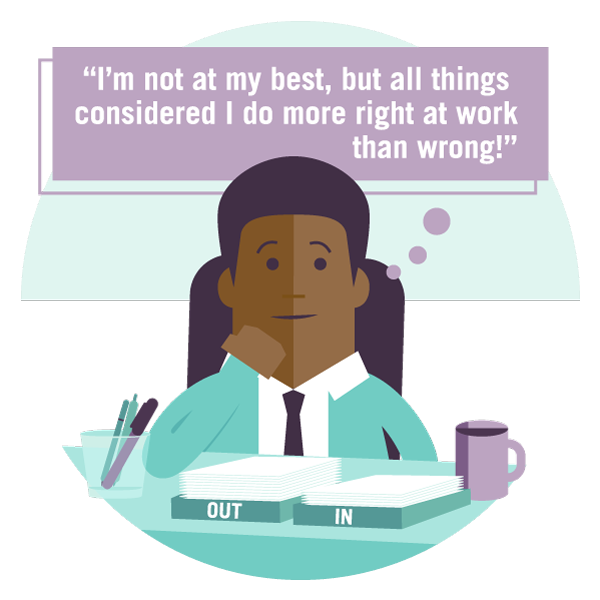
After challenging his unhelpful thoughts, Sean was able to rework his thinking and create a balanced thought: “I’m not at my best right now, and I make mistakes, but all things considered I do more things right than wrong.” Sean noticed that self-encouragement worked better than self-criticism. He felt better, could focus on his work, and move on with his day more quickly when he shifted how he talked to himself. Sean now tries his best to be kind to himself, especially when he makes mistakes.
Good job! You’ve Created a Thought Record
Download Your Worksheet
Good job! You’ve learned how to make a thought record and challenge unhelpful thoughts. If you’ve been hard on yourself or thinking unhelpful thoughts for awhile, it can take some work to break that habit. The more you practice thinking balanced or helpful thoughts, the more natural it begins to feel. Try challenging a few thoughts a day and share them with your therapist who can help you tweak them until you don’t believe them anymore. If you have a few unhelpful thoughts that keep creeping back, it’s a good idea to write down a few balanced thoughts or responses on a card to keep as a handy reminder.
Congratulations! You’ve Started to Practice Challenging Your Thoughts
Continue making thought records and creating balanced or helpful thoughts. If you’re feeling stuck you can review this unit or talk to your therapist or healthcare provider.
Understanding Medication
7minThe use of medication in the treatment of anxiety and depression can be very important. When other types of treatment have not made you feel better, it might be time to try medication. Medication can be used on it’s own or with other treatments, like therapy.
- Why Medication?
- Types of Medication
- Side Effects
- Expectations
! For your privacy, this site does not save what you type. To save it or have a therapist review it, please download your work at the end of your session.
Why Medication?
Doctors use medication to treat anxiety and depression for the same reason they use it to treat many other health concerns. Sometimes, it’s the best way to get the results you need.
Take someone with high blood sugar. They might start by exercising more and changing their diet to try and fix the problem. If this doesn’t lower their sugar levels, their doctor might start them on medication.
The same is true for anxiety and depression. Some people suffer so much that therapy isn’t enough. Perhaps your anxiety or depression is so strong that starting therapy feels too hard to do right now. Medication can help boost your energy and ease your symptoms. Once you are feeling a bit of relief, you’ll be able to focus on therapy and other treatments.
Types of Medication
The same medications are often used to treat anxiety and depression. We can divide these medications into 2 groups: slow and fast-acting.
Slow-acting medications are a bit like vitamins. They take a while to build up in your body, but have a long lasting effect. These medications help restore the balance of the chemical messengers in your brain. Different types work on different messengers. Slow-acting medications are the most common treatment for depression and anxiety.
Fast-acting drugs are like rescue agents. They work right away to help get you through an intense episode like panic. Some people also use them to get to sleep. Fast-acting medications only treat the “here and now.” It is important to note that you can develop a tolerance to some of these medications. This means that over time you might need more of the drug to get the same relief. For this reason, rescue agents aren’t a good long-term solution. But they can help you get through the days or weeks it takes for your slow-acting medication to kick in.
Finding the Right Medication
Our brains are all unique. There is no one medication that works for everyone. One drug might do wonders for you and have no effect on someone else. It’s common to try 2 or 3 different medications before finding the right one for you.
Your medication should improve your quality of life. The benefits should outweigh the negatives. One possible negative is side effects. Antidepressants and anti-anxiety medications can cause dry mouth, stomach aches, dizziness, and headaches. Some might make you feel a bit “off.” Most of the time these side effects disappear after a few weeks. But if they continue, or are too painful to push through, then this medication is not right for you. Some side effects, like increased thoughts of suicide, are very serious, but uncommon.
Talk to your doctor as you begin trying medication. It’s important to find the right drug and the right dose for you. Remember that medication should make you feel better overall, not worse.
Addiction
People often worry that if they start medication they’ll always need it and won’t be able to stop.
Here’s what you need to know:
The slow-acting group of medications do not cause cravings. They are not addictive. But you might feel a bit sick when you stop. For example, you may have bad headaches or dizziness. Going off your medication slowly, in steps, can help avoid these symptoms. Make sure you talk to your doctor.
People can build a tolerance to fast-acting medications. This means you might want more and more of the drug to get relief. Luckily, these medications are not the main treatment for depression and anxiety. It’s important to use these drugs carefully. Take them only when it’s urgent, not all the time.
Length of Treatment
Another concern many people have is how long they’ll need to take medication.
Even if you no longer feel depressed or anxious, you should not stop treatment too soon. It’s recommended that you stay on your medication for 6 months to a year. This will help relieve you of symptoms and stop them from coming back.
If your anxiety or depression keeps coming back, you can stay on medication long term. This is no different from other chronic health issues. Diabetics take insulin daily for life.
Expectations
The main drugs used to treat anxiety and depression are slow-acting. This means you won’t get results overnight! It will take a few days or weeks for you to gradually feel better. Sometimes your friends or family might notice changes before you do.
Medication won’t cure all of your problems. Instead, it will help boost your energy and mood enough to get started. It might make you feel more social or get your appetite back to normal. When you can concentrate and sleep better you’ll be more able to work on your other problems. Medication is a stepping-stone that can give you the push you need to take on other treatments like therapy.
Good Job. You're Exploring Your Options.
When you know what medication can and can't do, it can make a world of difference. Think about whether this is an option you're interested in, and talk to your doctor.
Keep practicing. Download reusable worksheets and audio guides for Anxiety.
Disclaimer
Please be aware that keltyskey.com does not save your private information. No entries made during this session will be saved. If you’d like to have a copy of your work, you must download your worksheet now.
Would you like to download your worksheet?
We use cookies and similar technologies to operate this site and help us understand how you use it. By continuing to browse this website, you are agreeing to our use of cookies and confirming your review of our privacy policy.
